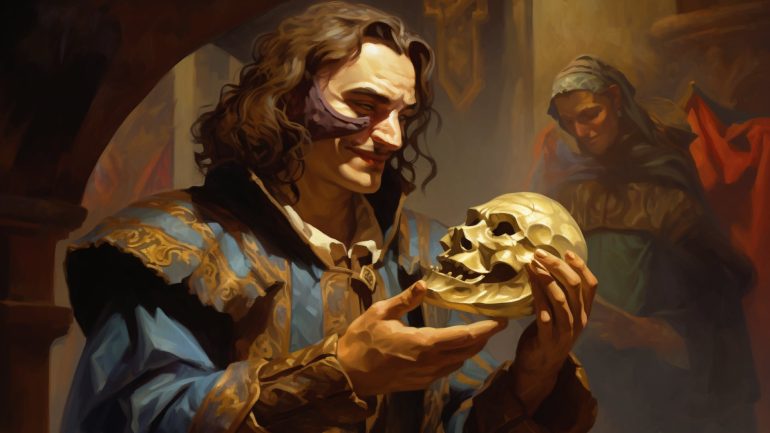What is Disguise Self 5E?
Disguise Self 5E is a 1st level illusion spell natively available to Artificers, Bards, Sorcerers, and Wizards. It requires vocal and somatic components and takes an action to cast. It allows the caster to change their appearance, including what they are wearing and carrying, with an illusion. This illusion can make the caster seem up to 1 ft. taller or shorter and fatter or thinner than they actually are. You must choose a form that has the same basic arrangement of limbs, otherwise, the appearance is completely up to you. Physical interaction reveals this to be an illusion, such as appearing thinner would mean a hand would bump into what would look like open air, but would actually collide with your natural girth. To discern that your appearance is false without touching you, a creature must use its action and make an Investigation check against your spell save DC.
Is Disguise Self 5E a good spell?
Disguise Self is an excellent spell for the social pillar, allowing you to potentially gain access to areas and information that you wouldn’t normally be able to, or even attribute your negative actions to the person you’re disguised as. Whilst being an illusion can be a drawback versus something like Alter Self which would actually make you look different, the fact that Disguise Self can also change the appearance of your clothes and belongings is a huge boon for rapid disguise.
The main ways to improve this spell are to get it at will, such as the Mask of Many Faces invocation, which would drastically change how you could approach situations. You should also invest in Charisma skills such as Deception and Persuasion so that you can leverage your disguise as much as possible. The Actor feat would also allow you to impersonate the voice of the person you’re disguised as, completing your facade.
How can you get Disguise Self 5E?
If you’re interested in walking a mile in what appears to be another’s shoes, fear not! Here is a list of how you can grab this mischievous spell:
- Artificer, Bard, Sorcerer, and Wizard – All of these classes get access to Disguise Self on their spell lists.
- Arcane Trickster (Rogue Subclass) – This Rogue can choose spells from the Wizard spell list, and can choose Disguise Self as one of their unrestricted spells as it matches their illusion restriction.
- Eldritch Knight (Fighter Subclass) – Similar to above, this Fighter subclass can choose spells from the Wizard list and can choose Disguise Self as one of their unrestricted spells.
- Gloom Stalker (Ranger Subclass) – These shadowy Rangers get this spell from their Gloom Stalker Spells feature.
- Trickery Domain (Cleric Subclass) – This domain gets Disguise Self as an always-prepared spell from their Domain Spells feature.
- Mask of Many Faces (Eldritch Invocation) – Warlocks, or PCs with the Eldritch Adept feat, can cast Disguise Self at will without needing to spend a spell slot.
- Replicate Magic Item (Artificer Infusion) – From 10th level onwards, Artificers can use this infusion to create a Hat of Disguise, which allows the wearer to cast Disguise Self at will.
- Deep Gnome (Race) – The Monsters of the Multiverse version of this race can cast Disguise Self, as well as Nondetection, once per long rest for free or more than that with any spell slots they may have.
- Firbolg (Race) – Both versions of this gentle giant get a special version of Disguise Self from their Firbolg Magic feature. This version allows them to appear up to 3 ft. shorter, rather than the standard 1 ft.
- Hexblood (Race) – The Hex Magic feature allows these hag-related fey folk to cast Disguise Self and Hex once per long rest.
- Tiefling (Race Variant) – Both the Dispater and Glasya variants of the Tiefling from MTF gain the ability to cast this spell once per long rest.
- Aberrant Dragonmark (Feat) – This feat allows gives you a 1st level Sorcerer spell which you can cast once per short or long rest, as well as a cantrip from the Sorcerer spell list.
- Artificer Initiate (Feat) – Budding Artificers can get a free casting of Disguise Self once per long rest, an Artificer cantrip, and proficiency in an artisan’s tool of their choice with this feat.
- Initiate of High Sorcery (Feat) – By choosing the Lunitari option you can choose Disguise Self as well as either Color Spray, Feather Fall, or Longstrider and you can cast both once per long rest without a spell slot.
- Magic Initiate (Feat) – If you choose Bard, Sorcerer, or Wizard as the spell list then you can get a once per long rest casting of Disguise Self and two cantrips from the same spell list. You can’t cast Disguise Self gained in this way with spell slots unless you have at least one level in the class you chose for this feat.
- Shadow Touched (Feat) – This feat will give you a casting of Disguise Self and Invisibility once a long rest and allow you to cast both with any relevant spell slots you may have.
- Strixhaven Initiate (Feat) – Every college option would allow you to get a casting of Disguise Self, as well as two cantrips from a short list which depends on which college you choose.
- Svirfneblin Magic (Feat) – This feat allows deep gnomes to cast Disguise Self, Blur, and Blindness/Deafness once per long rest and Nondetection at will. This spell is really intended for the MTF version of the deep gnome, but the Monsters of the Multiverse version can also take it, just with some overlap/redundancy.
How to roleplay Disguise Self 5E spell
Need some help roleplaying the Disguise Self 5E spell? Here are some examples to help you out:
- The Rogue uses Disguise Self to transform her appearance into that of a high-ranking military officer. She confidently strolls into the enemy’s war camp, gathering vital intelligence while her new form grants her access to areas that would have been otherwise off-limits.
- After stealing a valuable artifact from a heavily guarded temple, the Wizard casts an illusion spell to make himself appear as one of the temple’s monks. He then casually walks past the real monks and temple guards, his stolen prize hidden under his false robe.
- The Bard needs to convince a city council to take action against an impending threat. Knowing they are more likely to listen to someone of higher status, she uses a transformative melody to assume the visage of a well-known diplomat and gains an audience, making her case with added weight.
If you found this guide planning your next Gloom Stalker, check out our Ranger 5E guide, or if you just like learning about 5E spells, check out our DnD 5E spells section. Good luck out there adventurers, and until next time, remember to not let anyone get too close when they admire what appears to be luxurious dress robes!






